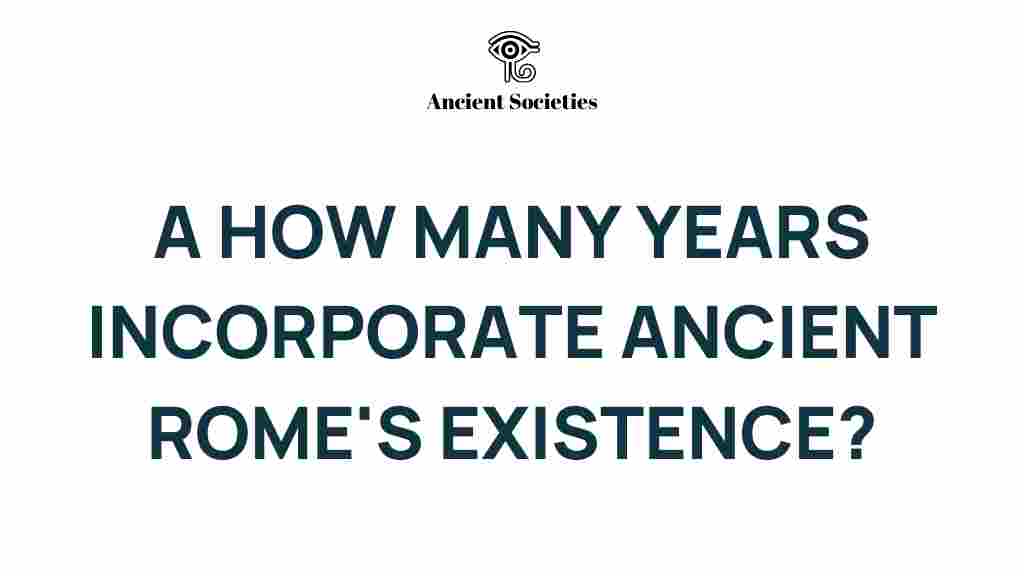Unraveling the Timeline: How Many Years Did Ancient Rome Last?
Ancient Rome is one of the most celebrated civilizations in history, known for its remarkable achievements in architecture, law, governance, and culture. The longevity of this empire is a subject of fascination for historians, archaeologists, and enthusiasts alike. This article will explore the timeline of Ancient Rome, delving into its extensive history, the factors contributing to its durability, and the profound influence it continues to have on modern society.
The Timeline of Ancient Rome
To understand how many years Ancient Rome lasted, it is essential to break down its timeline into significant periods:
1. The Roman Kingdom (753 BC – 509 BC)
The foundation of Ancient Rome is traditionally dated to 753 BC when Romulus, its legendary founder, established the city. This period, known as the Roman Kingdom, lasted until the establishment of the Roman Republic in 509 BC. Key features of this period include:
- Monarchical rule with seven legendary kings.
- Development of Roman religious and cultural practices.
- Early territorial expansion and establishment of social structures.
2. The Roman Republic (509 BC – 27 BC)
The Roman Republic was characterized by a complex system of governance and social structure. This era saw significant political and military developments, including:
- The establishment of the Senate and various elected magistrates.
- Expansion through wars, including the Punic Wars against Carthage.
- Social conflicts such as the Struggle of the Orders, leading to greater rights for plebeians.
This period lasted nearly 482 years and set the groundwork for the transition to the Roman Empire.
3. The Roman Empire (27 BC – AD 476)
The Roman Empire began with Augustus (formerly Octavian) declaring himself the first emperor in 27 BC, marking a new chapter in Ancient Rome’s history. This vast empire would last for nearly 500 years until the fall of the Western Roman Empire in AD 476. Key points include:
- The Pax Romana, a time of peace and prosperity.
- Extensive territorial expansion reaching from Britain to the Middle East.
- Significant advancements in architecture, law, and engineering.
During this era, Rome reached its zenith, influencing many aspects of modern civilization.
4. The Byzantine Empire (AD 476 – 1453)
While the Western Roman Empire fell in AD 476, the Eastern Roman Empire, known as the Byzantine Empire, continued to thrive for nearly another thousand years until the fall of Constantinople in 1453. This period is crucial for understanding the legacy of Ancient Rome:
- Continuation of Roman law and governance.
- Preservation and transformation of Roman culture and traditions.
- Influence on Eastern Europe and the spread of Christianity.
Factors Contributing to the Longevity of Ancient Rome
The timeline of Ancient Rome showcases a civilization that endured for over a millennium, with both internal and external factors contributing to its longevity:
- Innovative Governance: The Roman Republic’s political structure allowed for adaptability and citizen participation, creating a sense of ownership among the populace.
- Military Prowess: Rome’s formidable military ensured territorial expansion and the enforcement of peace within the empire.
- Infrastructure and Engineering: Advanced engineering skills led to the construction of roads, aqueducts, and public buildings, facilitating trade and communication.
- Cultural Assimilation: Rome’s ability to assimilate conquered peoples and cultures helped maintain stability and loyalty to the empire.
Archaeological Insights into Ancient Rome
Archaeology has played a vital role in unraveling the history of Ancient Rome. Excavations of sites such as the Forum, the Colosseum, and Pompeii have provided invaluable insights into Roman society, culture, and daily life. Key archaeological findings include:
- Urban Planning: The layout of Roman cities reflects sophisticated planning and organization.
- Art and Sculpture: Roman art, influenced by Greek styles, showcases the empire’s cultural priorities and values.
- Daily Life Artifacts: Tools, pottery, and household items reveal the everyday lives of Roman citizens.
The Cultural Influence of Ancient Rome
Ancient Rome’s culture has profoundly influenced Western civilization. Its contributions include:
- Language: Latin, the language of Ancient Rome, is the precursor to the Romance languages and significantly impacts modern vocabulary.
- Law and Governance: Roman law laid the foundation for legal systems in many countries today.
- Architecture: Roman architectural innovations, such as the arch and concrete, are still prominent in modern buildings.
Troubleshooting Common Misconceptions About Ancient Rome
Despite its significant historical impact, there are several misconceptions about Ancient Rome:
- Myth of Decline: Some believe that the fall of Rome was sudden, whereas it was a gradual process influenced by economic, military, and political factors.
- Uniformity of Culture: Many assume Roman culture was homogenous; in reality, it was diverse and varied across different regions of the empire.
- Roman Society: It’s often thought that Roman society was rigid; however, it evolved over centuries, adapting to changing circumstances.
Conclusion
In summary, Ancient Rome lasted for over a millennium, from its legendary founding in 753 BC to the fall of the Western Roman Empire in AD 476, with the Byzantine Empire continuing until 1453. The timeline of Ancient Rome is marked by significant political, military, and cultural developments that shaped not only its destiny but also the future of Western civilization. The archaeological findings and cultural influences of Ancient Rome continue to be studied and celebrated, underscoring the empire’s remarkable longevity and enduring legacy.
For more in-depth insights into the history of Ancient Rome, consider visiting this detailed resource. Additionally, if you’re interested in the archaeological discoveries that have shaped our understanding of Ancient Rome, check out this informative article.
This article is in the category History and created by AncientSocieties Team
